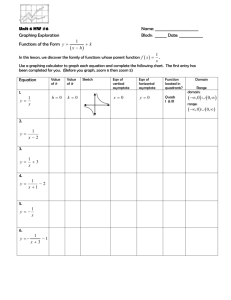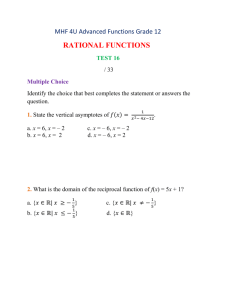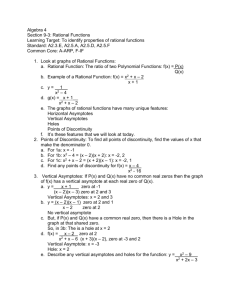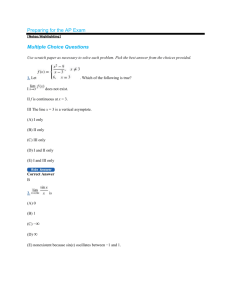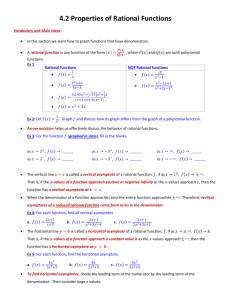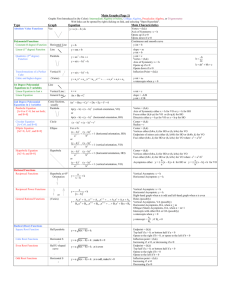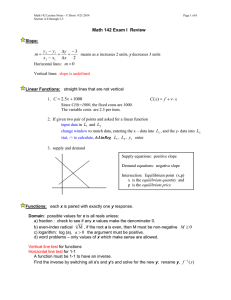Handout #6
advertisement
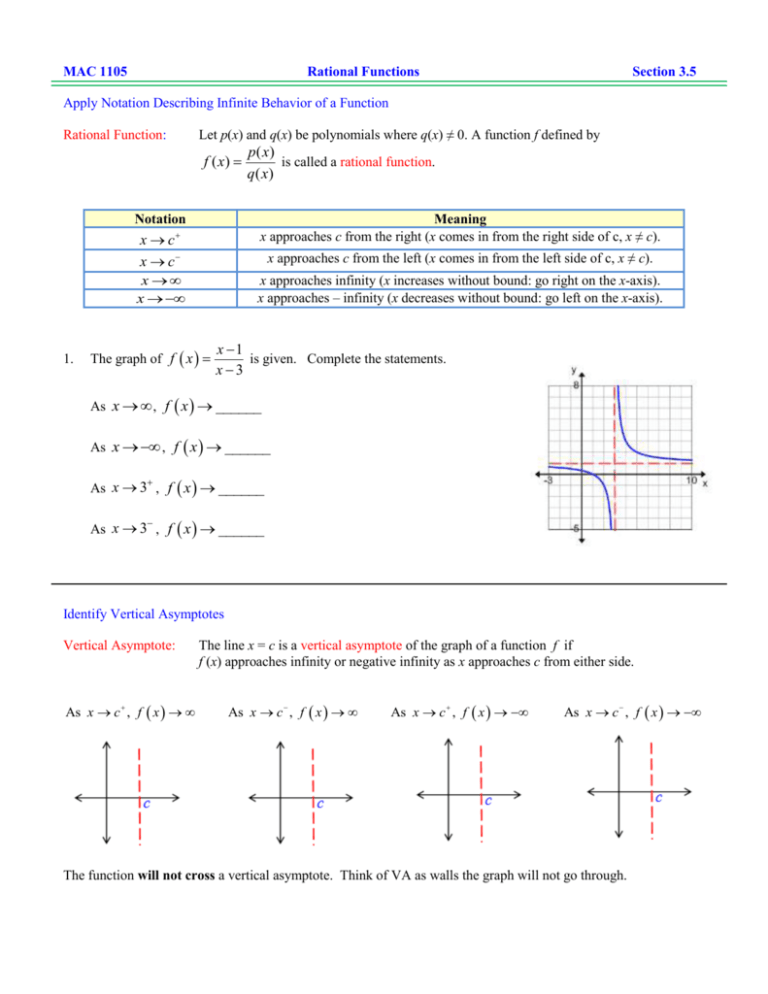
MAC 1105 Rational Functions Section 3.5 Apply Notation Describing Infinite Behavior of a Function Let p(x) and q(x) be polynomials where q(x) ≠ 0. A function f defined by Rational Function: f ( x) Notation Meaning x approaches c from the right (x comes in from the right side of c, x ≠ c). xc x c x approaches c from the left (x comes in from the left side of c, x ≠ c). x x 1. p ( x) is called a rational function. q ( x) x approaches infinity (x increases without bound: go right on the x-axis). x approaches – infinity (x decreases without bound: go left on the x-axis). The graph of f x x 1 is given. Complete the statements. x3 As x , f x ______ As x , f x ______ As x 3 , f x ______ As x 3 , f x ______ Identify Vertical Asymptotes Vertical Asymptote: As x c , f x The line x = c is a vertical asymptote of the graph of a function f if f (x) approaches infinity or negative infinity as x approaches c from either side. As x c , f x As x c , f x As x c , f x The function will not cross a vertical asymptote. Think of VA as walls the graph will not go through. Since we cannot divide by zero, we want to take out any value for x that makes the denominator zero. This will be a list of the form x = constant. Let f ( x) p ( x) where p(x) and q(x) have no common factors other than 1. To locate the vertical asymptotes of q ( x) f x , determine the real numbers x where the denominator is zero, but the numerator is nonzero. Identify the vertical asymptotes (if any). 2. f ( x) 5 x 8 5. f x x 3 x 4x 5 3. f ( x) 2x x 25 4. 2 2 6. f x f ( x) 4 x 9 x 3 x 2x 3 2 Identify Horizontal Asymptotes Horizontal Asymptote: The line y = d is a horizontal asymptote of the graph of a function f if f (x) approaches d as x approaches infinity or negative infinity. As x , f x d Think of these as horizontal walls – but these might be crossed. As x , f x d 2 Let f be a rational function defined by f ( x) an x n an1 x n1 an 2 x n2 ... a1 x a0 bm x m bm1 x m1 bm2 x m2 ... b1 x b0 where n is the degree of the numerator and m is the degree of the denominator. one horizontal asymptote at y 0 (the x-axis) if n m (top power smaller than bottom power) an (ratio of lead coefficients) if n m (top power equals bottom power) bm no horizontal asymptote if n m (top power bigger than bottom power) one horizontal asymptote, y Identify the horizontal asymptotes (if any). 5. f x 3x 2 x 9 6. f x 3x 2 x2 9 7. How do I know if a function crosses its horizontal asymptote? 8. f x 3x 2 x 9 f x 3x 2 x2 9 f x 3x3 x2 9 Graph Rational Functions f ( x) p ( x) where p(x) and q(x) are polynomials with no common factors. q ( x) Asymptotes: Determine if the function has vertical asymptotes and graph them as dashed lines. Determine if the function has a horizontal asymptote and graph as a dashed line. Determine if the function crosses the horizontal asymptote. Intercepts: Determine the x- and y-intercepts (easy points) Plot points: Plot points (you pick) on the left and right of the x-intercepts, vertical asymptotes. Find the point where the function crosses a horizontal asymptote (if any). Graph. Identify asymptotes. 9. y 1 x2 5 y x -5 5 -5 10. y 1 ( x 2) 2 5 y x -5 5 -5 11. y 2x x3 Will Casio help? Your Casio will make a table, but picking points might be easier. Start? –1 End? –5 Step? 1

